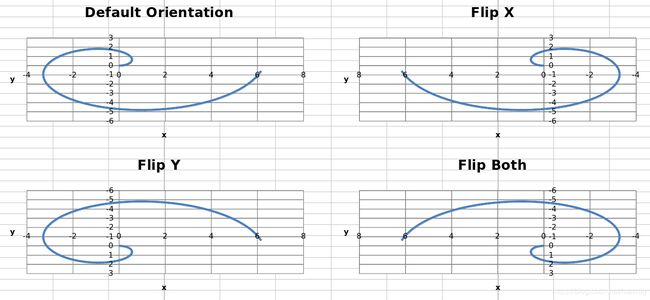openpyxl3.0官方文档(18)—— 坐标轴范围和对数缩放
坐标轴最小和最大值¶
为了在图表上显示特定区域,可以手动设置坐标轴的最小值和最大值。
from openpyxl import Workbook
from openpyxl.chart import (
ScatterChart,
Reference,
Series,
)
wb = Workbook()
ws = wb.active
ws.append(['X', '1/X'])
for x in range(-10, 11):
if x:
ws.append([x, 1.0 / x])
chart1 = ScatterChart()
chart1.title = "Full Axes"
chart1.x_axis.title = 'x'
chart1.y_axis.title = '1/x'
chart1.legend = None
chart2 = ScatterChart()
chart2.title = "Clipped Axes"
chart2.x_axis.title = 'x'
chart2.y_axis.title = '1/x'
chart2.legend = None
chart2.x_axis.scaling.min = 0
chart2.y_axis.scaling.min = 0
chart2.x_axis.scaling.max = 11
chart2.y_axis.scaling.max = 1.5
x = Reference(ws, min_col=1, min_row=2, max_row=22)
y = Reference(ws, min_col=2, min_row=2, max_row=22)
s = Series(y, xvalues=x)
chart1.append(s)
chart2.append(s)
ws.add_chart(chart1, "C1")
ws.add_chart(chart2, "C15")
wb.save("minmax.xlsx")

在某些情况下,如上面代码所示,设置坐标轴范围实际上等同于显示数据的子范围。对于大型数据集,使用使用Excel或者Open/Libre Office来绘制散点图(可能还有其他)时,选择数据子集方式要比设置坐标轴范围的速度更快。
对数缩放¶
x轴和y轴都可以对数缩放。对数的基可以设置为任何有效的浮点。如果x轴按对数缩放,则将丢弃区域中的负值。
from openpyxl import Workbook
from openpyxl.chart import (
ScatterChart,
Reference,
Series,
)
import math
wb = Workbook()
ws = wb.active
ws.append(['X', 'Gaussian'])
for i, x in enumerate(range(-10, 11)):
ws.append([x, "=EXP(-(($A${row}/6)^2))".format(row = i + 2)])
chart1 = ScatterChart()
chart1.title = "No Scaling"
chart1.x_axis.title = 'x'
chart1.y_axis.title = 'y'
chart1.legend = None
chart2 = ScatterChart()
chart2.title = "X Log Scale"
chart2.x_axis.title = 'x (log10)'
chart2.y_axis.title = 'y'
chart2.legend = None
chart2.x_axis.scaling.logBase = 10
chart3 = ScatterChart()
chart3.title = "Y Log Scale"
chart3.x_axis.title = 'x'
chart3.y_axis.title = 'y (log10)'
chart3.legend = None
chart3.y_axis.scaling.logBase = 10
chart4 = ScatterChart()
chart4.title = "Both Log Scale"
chart4.x_axis.title = 'x (log10)'
chart4.y_axis.title = 'y (log10)'
chart4.legend = None
chart4.x_axis.scaling.logBase = 10
chart4.y_axis.scaling.logBase = 10
chart5 = ScatterChart()
chart5.title = "Log Scale Base e"
chart5.x_axis.title = 'x (ln)'
chart5.y_axis.title = 'y (ln)'
chart5.legend = None
chart5.x_axis.scaling.logBase = math.e
chart5.y_axis.scaling.logBase = math.e
x = Reference(ws, min_col=1, min_row=2, max_row=22)
y = Reference(ws, min_col=2, min_row=2, max_row=22)
s = Series(y, xvalues=x)
chart1.append(s)
chart2.append(s)
chart3.append(s)
chart4.append(s)
chart5.append(s)
ws.add_chart(chart1, "C1")
ws.add_chart(chart2, "I1")
ws.add_chart(chart3, "C15")
ws.add_chart(chart4, "I15")
ws.add_chart(chart5, "F30")
wb.save("log.xlsx")
这将生成五个类似的图表:

五张图使用了相同的数据。其中,第一个图未缩放,第二和三张图分别缩放了X和Y轴,第四张图XY轴均进行了缩放,对数基数设置为10;最后的图表XY轴均进行了缩放,但对数的底设置为e。
轴线方向¶
坐标轴可以正常显示,也可以反向显示。轴方向由
orientation属性控制,minMax表示正向,maxMin表示反向。
from openpyxl import Workbook
from openpyxl.chart import (
ScatterChart,
Reference,
Series,
)
wb = Workbook()
ws = wb.active
ws["A1"] = "Archimedean Spiral"
ws.append(["T", "X", "Y"])
for i, t in enumerate(range(100)):
ws.append([t / 16.0, "=$A${row}*COS($A${row})".format(row = i + 3),
"=$A${row}*SIN($A${row})".format(row = i + 3)])
chart1 = ScatterChart()
chart1.title = "Default Orientation"
chart1.x_axis.title = 'x'
chart1.y_axis.title = 'y'
chart1.legend = None
chart2 = ScatterChart()
chart2.title = "Flip X"
chart2.x_axis.title = 'x'
chart2.y_axis.title = 'y'
chart2.legend = None
chart2.x_axis.scaling.orientation = "maxMin"
chart2.y_axis.scaling.orientation = "minMax"
chart3 = ScatterChart()
chart3.title = "Flip Y"
chart3.x_axis.title = 'x'
chart3.y_axis.title = 'y'
chart3.legend = None
chart3.x_axis.scaling.orientation = "minMax"
chart3.y_axis.scaling.orientation = "maxMin"
chart4 = ScatterChart()
chart4.title = "Flip Both"
chart4.x_axis.title = 'x'
chart4.y_axis.title = 'y'
chart4.legend = None
chart4.x_axis.scaling.orientation = "maxMin"
chart4.y_axis.scaling.orientation = "maxMin"
x = Reference(ws, min_col=2, min_row=2, max_row=102)
y = Reference(ws, min_col=3, min_row=2, max_row=102)
s = Series(y, xvalues=x)
chart1.append(s)
chart2.append(s)
chart3.append(s)
chart4.append(s)
ws.add_chart(chart1, "D1")
ws.add_chart(chart2, "J1")
ws.add_chart(chart3, "D15")
ws.add_chart(chart4, "J15")
wb.save("orientation.xlsx")
